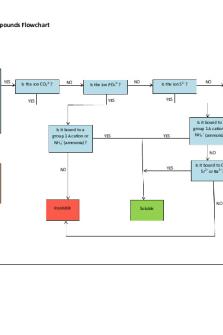Alexander Ayala Solubility and Miscibility PDF

| Title | Alexander Ayala Solubility and Miscibility |
|---|---|
| Author | Alexander Ayala |
| Course | Organic Chemistry I |
| Institution | Grand Canyon University |
| Pages | 4 |
| File Size | 298.4 KB |
| File Type | |
| Total Downloads | 28 |
| Total Views | 137 |
Summary
Second lab assignment...
Description
CHM-231L: Solubility and Miscibility Directions: All answers should be short, precise and professional. Alexander Ayala
Name:
Data Part A M = Miscible; PM = Partial Miscible; I = Immiscible Hexane
Ethyl acetate
2 - propanol
water (5 drops)
Miscible
Miscible
Miscible
water (10 drops)
Miscible
Partial Miscible
Miscible
water (15 drops)
Partial Miscible
Immiscible
Miscible
water (20 drops)
Immiscible
Immiscible
Partial Immiscible
Part B S = Soluble; PS = Partial Soluble; I = Insoluble Benzoic acid
Ethyl-4-aminobenzoate
Biphenyl
Room Temp
Hot
Cold
Room Temp
Hot
Cold
Room Temp
Hot
Cold
water
PS
PS
I
PS
PS
I
PS
S
I
ethyl acetate
PS
S
I
S
S
S
PS
S
PS
hexane
PS
PS
I
I
PS
I
PS
S
I
Part C Concentration Solubility of Acetate = 1g per 1 mL of water
© 2018. Grand Canyon University. All Rights Reserved.
Size
10 drops Additional 10 drops
Alcohol #1
Alcohol #2
Alcohol #3
Butanol
Isopropyl
Octanol
Layer
Somewhat mixed
Layer
Layer
Somewhat mixed/Small layer
Layer
Questions What are the three intermolecular interactions that affect miscibility of two solvents?
1.
i. ii. iii. 2.
Click or tap here to enter text. Click or tap here to enter text. Click or tap here to enter text. How does heat affect solubility of solids in solution? Click or tap here to enter text.
3.
What intermolecular force makes group I salts soluble in water? Click or tap here to enter text.
4. Compare the following solvents, rank in polarity most to least. ethanol, hexane, 2-butanone, water, benzene, diethyl ether, ethyl acetate, acetone Click or tap here to enter text. Which solvents would be completely miscible in water in all proportions? Click or tap here to enter text. 5.
How do drug manufacturers increase the water solubility of drugs? Click or tap here to enter text. © 2018. Grand Canyon University. All Rights Reserved.
6.
Give two reasons why acetamide has a higher boiling point than water? i. ii.
Click or tap here to enter text. Click or tap here to enter text.
7. Give two reasons why is it important to keep good records, i.e. lab notebook, in chemistry? i. ii.
Click or tap here to enter text. Click or tap here to enter text.
8. Complete the assignment of the unknowns from your lab notebook data. Predict the solubility of each compound and include a brief reason for your decision. (Bold or change color of soluble compounds). Reason: Benzoic Acid
Water
Diethyl ether
1M NaOH
1 M HCl
Benzoic acid is a weak acid, NaOH is a strong base: would form a pellet. Unknown solution performed a chemical reaction into a homogenous solution. NO
pAminobenzoic Acid Ethyl-4aminobenzoate Citric Acid
Water
Diethyl ether
1M NaOH
1 M HCl
Slightly soluble in water, amine group would react with HCl to form a salt. Soluble in diethyl ether.
Water
Diethyl ether
1M NaOH
1 M HCl
Soluble in diethyl ether and HCl.. Insoluble in NaOH and water.
Water
Diethyl ether
1M NaOH
1 M HCl
Citric acid is a weak acid and would have formed a
© 2018. Grand Canyon University. All Rights Reserved.
pellet in NaOH. Is miscible in water. Naphthalene
Water
Diethyl ether
1M NaOH
1 M HCl
Hydrocarbon chain would not dissolve in water. Would mix with HCl due to the acid group.
Which one of the above is your unknonwn? (Give uknown # and name) The unknown chemical #4 is p-aminobenzoate. When reacted with sodium hydroxide, the 1o amine group and carboxyl group will react with the sodium hydroxide in a chain order. Firstly, the carboxyl group will react to form COONa and -OH, with -OH being an alcohol. The free alcohol will react with the amine group and form hydroxylamine, leaving the original chemical to become sodium benzoate. The constituent chemicals are hydroxylamine and water, all miscible with each other and soluble at room temperature.
© 2018. Grand Canyon University. All Rights Reserved....
Similar Free PDFs

AC324 Ayala
- 14 Pages

Solubility and Solutions
- 3 Pages

27 Solubility-S - Solubility
- 4 Pages

Fase2 Juan Ayala 536
- 5 Pages

Solubility Guidelines
- 1 Pages

Solubility Rules
- 1 Pages

Predicting Solubility
- 1 Pages

Solubility Flowchart
- 2 Pages

Solubility Rules
- 1 Pages

Solubility Rules
- 1 Pages

Solubility Table
- 1 Pages
Popular Institutions
- Tinajero National High School - Annex
- Politeknik Caltex Riau
- Yokohama City University
- SGT University
- University of Al-Qadisiyah
- Divine Word College of Vigan
- Techniek College Rotterdam
- Universidade de Santiago
- Universiti Teknologi MARA Cawangan Johor Kampus Pasir Gudang
- Poltekkes Kemenkes Yogyakarta
- Baguio City National High School
- Colegio san marcos
- preparatoria uno
- Centro de Bachillerato Tecnológico Industrial y de Servicios No. 107
- Dalian Maritime University
- Quang Trung Secondary School
- Colegio Tecnológico en Informática
- Corporación Regional de Educación Superior
- Grupo CEDVA
- Dar Al Uloom University
- Centro de Estudios Preuniversitarios de la Universidad Nacional de Ingeniería
- 上智大学
- Aakash International School, Nuna Majara
- San Felipe Neri Catholic School
- Kang Chiao International School - New Taipei City
- Misamis Occidental National High School
- Institución Educativa Escuela Normal Juan Ladrilleros
- Kolehiyo ng Pantukan
- Batanes State College
- Instituto Continental
- Sekolah Menengah Kejuruan Kesehatan Kaltara (Tarakan)
- Colegio de La Inmaculada Concepcion - Cebu




